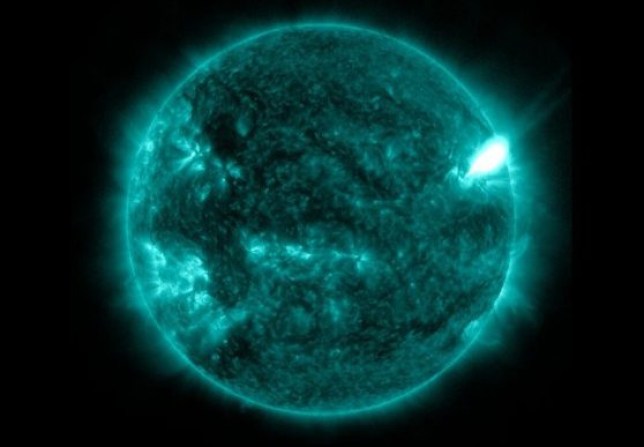A giant sunspot exploded at the weekend, causing a radio blackout over parts of the US and the Pacific ocean.
The phenomenon was an ‘X-class’ solar flare, the largest, most disruptive of flares.
The loss of signal for over 30 minutes after the flare would have mostly been noticed by mariners and amateur radio operators.
Nasa’s Solar Dynamics Observatory (SDO) recorded the extreme ultraviolet flash in a stunning video.
According to the Met Office, minor or moderate radio blackouts are likely with the chance of a minor radiation storm throughout the period.
According to Spaceweather.com, this sunspot didn’t explode on its own, but was helped along by a plume of plasma curling over the Sun’s limb. Hot magnetised gas landing on the sunspot seems to have triggered the blast.
The Sun has seen a flurry of activity on its surface this year, with Nasa astronomers spotting multiple ‘coronal holes’ on our star.
The Sun’s magnetic field goes through a ‘solar cycle’ approximately every 11 years. We are currently in Solar Cycle 25, which forecasters didn’t expect to be this strong.
Now, it may be on track to rival some of the stronger cycles of the 20th century.
The monthly average sunspot number for June 2023 was 163, according to the Royal Observatory of Belgium’s Solar Influences Data Analysis Center. This is more than every month since September 2022.
The last time sunspot numbers were this high, the Sun was on the verge of launching the Great Halloween Storms of 2003, which included the strongest X-ray solar flare ever recorded (X45), auroras as far as the south of the US and a coronal mass ejection (CME) so powerful it was ultimately detected by the Voyager spacecraft at the edge of the solar system.
What is a solar flare?
According to the European Space Agency, a solar flare is an explosion that happens on the Sun when energy stored in ‘twisted’ magnetic fields (which can usually be found above sunspots) is released.
These can heat electromagnetic material to millions of degrees in just minutes, resulting in a burst of radiation across the electromagnetic spectrum, including from radio waves to gamma rays and X-rays.
Solar flares are classified by scientists according to how bright they are in X-ray wavelengths.
The smallest, C-class, are unlikely to make much impact on Earth, medium-sized ones – known as M-class, could cause some low-level damage, while the largest, known as X-Class, could be seriously disruptive.
Thankfully, this week’s explosion didn’t last long enough to cause a CME. They are different from solar flares in that they are a release of plasma and radiation from the Sun – although they can sometimes accompany these flares.
The most famous coronal mass ejection occurred in 1859, causing a geomagnetic storm called the Carrington Event as a pulse of charged particles bombarded Earth’s magnetosphere, and caused telegraph systems across the US and Europe to fail.
If this happened today, the results would be devastating – potentially wiping out satellite systems and power grids and causing trillions of pounds worth of damage.
MORE : Once upon a time, Jupiter caused chaos roaming around the solar system
MORE : 1,800,000 mph solar winds could affect satellites as hole rips in the Sun




Share this with